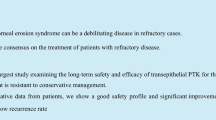Abstract
We sought to determine the efficacy of amniotic membrane transplantation (AMT) in the reconstruction of ocular surface. AMT was performed on 40 eyes with following indications: I, persistent corneal ulceration (n=12); II, impending perforation (n=6); III, persistent epithelial defect on the corneal graft (n=6); IV, recurrent pterygia (n=10), and V, risk of conjunctival scarring (n=6). Amniotic membrane was prepared from a fresh placenta under sterile conditions, washed with BSS containing penicillin, streptomycin, neomycin and amphotericin B and stored at −80 °C in 1:1 InoSol:Glycerol solution. Donor serological test for HIV, HBV and HCV were all negative. Associated surgical procedures according to indication were performed. Healing of the corneal ulcer in Group I was obtained in 67% of eyes at 1–3 weeks after surgery, Group II: AMT was followed by `a chaud' keratoplasty in 33% and by planned keratoplasty in 67% patients, Group III: healing of the defect in 33% of eyes in 2–5 postoperative weeks, Group IV: no recurrence of pterygium ingrowth in 70% in the follow up period of 6–14 months, and V: 84% of patients had good eye motility without any synechia formation. We concluded that AMT have shown to be effective in enhancing healing of the corneal defects, in prevention of symblepharon formation and recurrent pterygium ingrowth. In case of impending perforation, AMT alone was not a method of treatment but is useful as a first step procedure in preparing the eye for the corneal transplantation.
Similar content being viewed by others
References
Wiliams R, Buckley RJ. Pathogenesis and treatment of recurrent erosion. Br J Ophthalmol 1985; 69: 435–8.
Buxton JN, Fox ML. Superficial epithelial keratectomy in the treatment of epithelial basement membrane dystrophy. Arch Ophthalmol 1983; 101: 392–463.
McLean EN, MacRea SM, Rich LF. Recurrent erosion: treatment by anterior stromal puncture. Ophthalmology 1986; 93: 784–7.
Geggel HS. Successful treatment of recurrent corneal erosion with Nd Yag anterior stromal puncture. Am J Ophthalmol 1990; 110: 404–7.
Fagerholm P, Fitzsimmons TD, Oerndhal M, Oehman L, Tangroth B. Phototherapeutic keratectomy: Long-term results in 166 eyes. Refract Corneal Surg 1993; 9: 76–81.
Kim JC, Tseng SCG. Transplantation of preserved human amniotic membrane for surface reconstruction in severely damaged rabbit corneas. Cornea 1995; 14: 473–84.
Lee SH, Tseng SCG.Amniotic membrane transplantation for persistent epithelial defects with ulceration. Am J Ophthalmol 1997; 123: 303–12.
Heyworth P, Morlet N, Rayner S, Hykin P, Dart J. Natural history of recurrent erosion syndrome – a 4 year review of 117 patients. Br J Ophthalmol 1998; 82: 26–8.
King JR. The pterygium. Brief review and evaluation of certain methods of treatment.Arch Ophthalmol 1950; 44: 854–69.
Keizer RJW. Pterygium excision with or without postoperative irradiation, a doubleblind study. Doc Ophthalmol 1982; 52: 309–15.
Adamis AP, Starck T, Kenyon KR. The management of pterygium. Ophthalmol Clin North Am 1990; 3: 611–23.
Singh G, Wilson MR, Foster CS. Long term follow-up study of mitomycin eye drops as adjunctive treatment for pterygia and its comparison with conjuctival autograft transplantation. Cornea 1990; 9: 331–4.
Kenyon KR, Wagoner MD, Hettinger ME. Conjunctival autograft transplantation for advanced and recurrent pterygium. Ophthalmology 1985; 92: 1461–70.
Allan BD, Short P, Crawford GJ et al. Pterygium excision with conjunctival autografting: an effective and safe technique. Br J Ophthalmol 1993; 77: 698–701.
Vrabec MP, Weisenthal RW, Elsing SH. Subconjunctival fibrosis after conjunctival autograft.Cornea 1993; 12: 181–3. Neuhaus RW, Baykis HI, Shorr N. Complications at mucous membrane donor sites. Am J Ophthalmol 1982; 93: 643–6.
Prabhasawat P, Tseng CG. Impression cytology study of epithelial phenotype of ocular surface reconstruction by preserved human amniotic membrane. Arch Ophthalmol 1997; 115: 1360–7.
Russo RG, Thorgeirsson U, Liotta LA. In vitroquantitative assay of invasion using human amnion. In: Liotta LA, Hart IR, eds. Invasion and Metastasis. Dordrecht, The Netherlands: Martin Nijhoff Publishers, 1982: 173–87.
Campbell S, Allen TD, Moser BB et al. The translaminal fibrils of the human amnion basement membrane. J Cell Sci 1989; 94: 307–18.
Trelford JD, Trelford-Sauder M. The amnion in surgery, past and present. Am J Obstet Gynecol 1979; 134: 833–45.
Stern M. The grafting of preserved amniotic membrane to burned and ulcerated surfaces, substituting skin grafts. J Am Med Assoc 1913; 60: 973–4.
Tokomori K, Ohkura M, Kitano Y, Hori T, Nakajo T. Advantages and pitfalls of amnion inversion repair for the treatment of large unruptured omphalocele:results of 22 cases. J Pediatr Surg 1992; 27: 882–4.
Tseng SCG, Prabashawat P, Lee SH. Amniotic membrane transplantation for conjunctival surface reconstruction. Am J Ophthalmol 1997; 124: 765–74.
de Roth A. Plastic repair of conjunctival defects with fetal membrane. Arch Ophthalmol 1940; 23: 522–5.
Vastine DW, Stewart WB, Schwab IR. Reconstruction of the periocular mucous membrane by autologous conjunctival transplantation. Ophthalmology 1982; 89: 1072–81.
Hirst LW, Sebban A, Chant D. Pterygium recurrence time. Ophthalmology 1994; 101: 755–8.
McCoombes JA, Hirst LW, Isbell GP. Sliding conjunctival autografting in the surgical management of pterygium. Eye 1993; 7: 634–8.
Terranova VP, Lyall RM. Chemotaxis of human gingival epithelial cells to laminin: a mechanism for epithelial apical migration. J Periodontol 1986; 57: 311–7.
Khodadoust AA, Silverstien AM, Kenyon KR et al. Adhesion of regenerating corneal epithelium: the role of basement membrane. Am J Ophthalmol 1968; 65: 339–84.
Guo M, Grinnell F. Basement membrane and human epidermal differentiation in vitro. J Invest Dermatol 1989; 93: 372–8.
Boudreau N, Sympson CJ, Werb Z et al. Suppression of ICE and apoptosis in mammary epithelial cells by extracellular matrix. Science 1995; 267: 891–3
Rights and permissions
About this article
Cite this article
Gabrić, N., Mravičić, I., Dekaris, I. et al. Human amniotic membrane in the reconstruction of the ocular surface. Doc Ophthalmol 98, 273–283 (1999). https://doi.org/10.1023/A:1002423621010
Issue Date:
DOI: https://doi.org/10.1023/A:1002423621010




